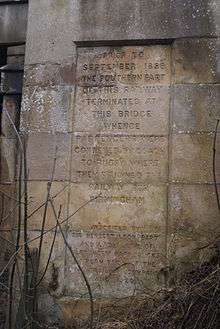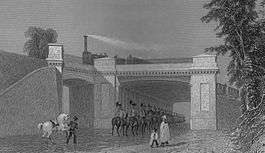Denbigh Hall railway station
| Denbigh Hall | |
|---|---|
|
A contemporary engraving showing the railway crossing Watling Street, near the site of the temporary station. | |
| Location | |
| Area | Buckinghamshire |
| Coordinates | 52°00′36″N 0°44′38″W / 52.010°N 0.744°WCoordinates: 52°00′36″N 0°44′38″W / 52.010°N 0.744°W |
| Grid reference | SP861354 |
| Operations | |
| Original company | London and Birmingham Railway |
| History | |
| 9 April 1838 | Opened |
| 17 September 1838 | Closed |
| Disused railway stations in the United Kingdom | |
|
Closed railway stations in Britain A B C D–F G H–J K–L M–O P–R S T–V W–Z | |
|
| |
Denbigh Hall railway station was a temporary terminus station on the London and Birmingham Railway in the Denbigh area of what is now Milton Keynes in Buckinghamshire, England. It was situated about one mile (1.6 km) north of Bletchley station, near a point where the railway crossed Watling Street. It was open for less than six months, between April and September 1838.
History
The route of the London and Birmingham Railway was designed and engineered by Robert Stephenson. One of the major civil engineering projects on the line was the 1 mile 656 yards (2.209 km) long Kilsby Tunnel in Northamptonshire,[1] between Bletchley and Rugby. Work on this tunnel was delayed, due to the builders unexpectedly encountering quicksand, and the route was not ready for the scheduled opening of the railway on 9 April 1838.[2][note 1] As a temporary measure, Denbigh Hall station was built near the point where the line crossed Watling Street, allowing passengers to transfer to stage-coaches to continue their journey to Rugby,[note 2] also near Watling Street, a distance of approximately 37 miles (60 km).[5] The station was named after an inn on Watling Street, dating from 1710.[6] The bridge over Watling Street still survives, but has been extended as the railway has widened.
The station closed with the opening of Kilsby Tunnel on 17 September 1838,[7][8] though the line still exists, forming part of the West Coast Main Line from London to Glasgow. The connection with the Varsity Line, which joins nearby, still bears the name Denbigh Hall Junction.[9]
Due to the temporary nature of the station, no images of it or records of its layout are known to exist, but a contemporary engraving by George Dodgson Callow and William Radclyffe shows a train on the bridge in its immediate vicinity.[10]
Commemoration

In 1920, Herbert Leon, 1st baronet of the nearby Bletchley Park, commissioned a plaque on the bridge to commemorate the station.[11] The plaque reads:
"Prior to September 1838 the southern part of this railway terminated at this bridge whence passengers were conveyed by coach to Rugby where they rejoined the railway for Birmingham. Inscribed by Sir Herbert Leon Bart and Lady Leon of Bletchley Park Bucks. By permission of the L&NW Railway Company August 1920."[12]
| Preceding station | Historical railways | Following station | ||
|---|---|---|---|---|
| Leighton[note 3] Line and station open |
London and Birmingham Railway | Rugby By stagecoach | ||
See also
| Wikimedia Commons has media related to Denbigh Hall railway bridge. |
Notes
- ↑ Some sources state a date of 9 April 1836, however this is almost certainly incorrect.
- ↑ This was not the current station at Rugby, but another temporary station, lasting between 1838 and 1840, north-west of the current location.[3][4]
- ↑ Now called Leighton Buzzard. Bletchley did not open until after Denbigh Hall had closed.
References
- ↑ Yonge, page 10
- ↑ "Kilsby Tunnel". Spartacus Educational. Retrieved 21 February 2013.
- ↑ Butt, page 201
- ↑ Dewick, page 10
- ↑ "Denbigh Hall Bridge, Bletchley". Our Transport Heritage. Retrieved 21 February 2013.
- ↑ "Milton Keynes Heritage" (map) - English Partnerships 2004
- ↑ Butt, page 77
- ↑ "London and Birmingham". Spartacus Educational. Retrieved 21 February 2013.
- ↑ Yonge, page 9
- ↑ Roscoe, facing page 76
- ↑ "Bletchley: Introduction". Living Archive. Retrieved 21 February 2013.
- ↑ Hughes, Les (27 November 2003). Henry Mundy: A Young Australian Pioneer. Next Century Books. p. 15. ISBN 978-0954401122. Retrieved 24 February 2013.
Bibliography
- Butt, R. V. J. (1995). The Directory of Railway Stations: details every public and private passenger station, halt, platform and stopping place, past and present (1st ed.). Sparkford: Patrick Stephens Ltd. ISBN 1-8526-0508-1. OCLC 60251199.
- Dewick, Tony (2002). Complete Atlas of Railway Station Names (1st ed.). Hersham: Ian Allan Publishing Ltd. ISBN 0-7110-2798-6.
- Roscoe, Thomas; Lecount, Peter (c. 1838). The London and Birmingham Railway. Retrieved 8 March 2013.
- Yonge, John (2005). Gerald Jacobs, ed. Railway Track Diagrams - Book 4: Midlands & North West (Quail Track Plans) (2nd ed.). Bradford on Avon: Trackmaps (formerly Quail Map Co.). ISBN 0-9549-8660-1. OCLC 133041211. Retrieved 21 February 2013.
